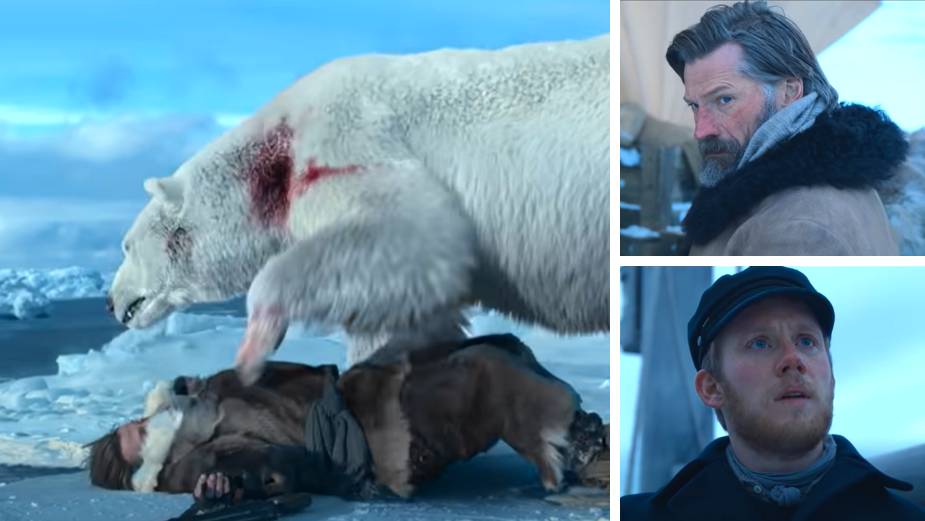
Sound Engineering on Netflix’s Against the Ice

Against the Ice, directed by Peter Flinth, is based on a true story, Two Against the Ice by Ejnar Mikkelsen. Starring Nikolaj Coster-Waldau and Joe Cole as Ejnar Mikkelsen and Iver Iversen, the film follows the story of a 1909 Denmark expedition that attempted to disprove the United States' claim to North-Eastern Greenland. Leaving their crew behind with the ship, Mikkelsen sleds across the ice with his inexperienced crew member, Iver and attempts to survive.
Here, Jungle sound engineer Stuart Allen-Hynd chats to LBB about his ADR work, post-syncing dialogue with the actors on Against The Ice.
LBB> What was the initial brief from the client and what was your approach?
Stuart Allen-Hynd> The brief was to re-record some dialogue that they couldn't use from set, because of external background noises or poor quality on-set recording, making the takes difficult to use.
The director was based in Denmark, and the production team and sound mixing studio were in Iceland. I was based here in London along with the actors.
I not only needed to capture the dialogue as well as I could using various mics, but I needed to help create a safe space where the actors felt comfortable and relaxed, as ultimately, they had to get into their acting headspace to deliver the lines.
During the recording, it was down to the director and the other sound mixer to convey what they needed from the actor, and direct the actor accordingly. I tried to take a step back, and ensure the recording was done as seamlessly as possible.
LBB> Have you worked on many films before? How does that compare to other projects you work on?
Stuart> I have worked on a few movies now, which is really exciting. Not only are these projects fun to work on, but also culturally impactful. A few of them are coming out later this year, but the last movie I can mention working on, was recording Oscar Isaac in the remake of The Addams Family.
Recording actors for movies is completely different to recording voice overs for commercials.The key difference is capturing an emotion as opposed to making sure every word is pronounced with clarity and energy, which tends to be more direction for commercial voice over recording.
I will do what I can to help the actor emotionally get there, but often that will be discussed between the director and the actor. Often, I will play the actor the scene they are dubbing in its entirety, to help them get into the headspace and hear the cues... sometimes turning the lights off helps, just to get the actor into the zone.
LBB> What are some of the biggest challenges when it comes to ADR? And what was your experience of those on this project?
Stuart> With recording ADR generally, the hardest challenge is to sync the booth recorded takes to the film, and make them sound as authentic as possible... like they were recorded on set.
As I wasn't mixing or sound designing this movie, it wasn't down to me to make the dubbing work, and in this case, the other sound designer and director would know pretty quickly just by the sonic of the take, whether it would work or not, so I wasn't making these decisions on this specific project.
For me the biggest challenge on this project was to work on an ADR session, where the sound mixing studio and the director were both remote. This meant technically there was a bit more going on, but after the first day we found our groove, and it went pretty smoothly.
LBB> What are some tips and tricks you can share on getting ADR right?
Stuart> On this movie, I was using the play and repeat method, where I would play the actor the line that was recorded on set two or three times and then he/she would repeat it with the same intonation and delivery. This helps when it comes to matching the line with the lip sync, but also means the actor can focus on listening to the intonation of the take, rather than reading the line off the page.
LBB> What other elements do you have to take into consideration?
Stuart> Prior to the session we will request a copy of the movie, any music, sound FX and dialogue recorded on set. We will also ask for a script of the lines we are replacing, along with any relevant time codes, so we can jump to the spot in the film easily without having to trawl through a 2-hour movie to find the line. We will play the actor their cue a few times, along with the sound FX and music to help get them in the zone.
LBB> How long does a project like this take to complete?
Stuart> This project took me three days, but it totally varies depending on how many lines need replacing, and how able the actors are to deliver the lines needed. Sometimes to make it more manageable for the actor, we will work across several days, as acting can be quite exhausting, especially if it's an intense scene!
LBB> What did you think of the final trailer? Do you have a favourite scene?
Stuart> It's really cool seeing some of the special FX in the trailer, which are now added. For example... the polar bear has now been finished and added in, which totally brings that shot to life! Hearing snippets of the final mix is really rewarding as well, as everything now sounds authentic and not like a studio recording!













